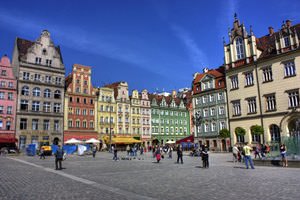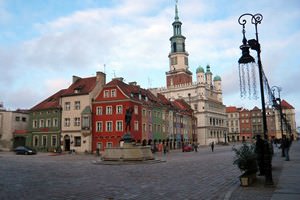
The third of the Polish territory is occupied by forests that are protected by the state. In this country, people highly value the nature and take a full range of measures to preserve it. The northern part is located on the picturesque coast of the Baltic Sea. The Sudeten and the Carpathians mountains are to the south. There are 23 national parks in Poland. The protected areas include the Augustow Forest and the Red Forest. The Augustow Forest is a virgin place that consists mostly of centuries-old pine and fir trees. There are many picturesque lakes and a huge number of various animals. The Red Forest is characterized by hilly terrain and numerous lakes. The largest of them is Vishtynetskoe Lake. The territory of the forest is inhabited by reindeer, roe deer, wild boar, beaver, raccoon dog, lynx, and wolf.
Since the formation of the Republic, the ethnic composition of Poland has been influenced by many factors particularly the Second World War and the …
Read further
The Biebrza Park is the largest national park in Poland; most of it is occupied by wetlands. The area is almost untouched by the man, which allowed a large number of birds to settle and nest in trees. In total, you can find more than 270 species of different birds in Biebrza Park. The place is their stop during the seasonal migration. The fauna is represented by wolves, foxes, and beavers. There are special hiking and bicycle trails for tourists, which allow going on an exciting journey. The tour is designed for a week, which is ideal for conducting research and bird observations in natural habitats. Fans of kayaking in mountains will be able to ride along the river Biebrza.
The second largest reserve in Poland is the Kampinos National Park, located near Warsaw. Despite its close proximity to the capital, the authorities managed to preserve the pristine landscape and nature. That shows how careful the people of Poland are when it comes to their natural resources. The park is incredibly popular among tourists and locals. Annually, it is visited by about a million people. There are more than 1700 different kinds of plants; 125 species are under the state protection. Rare black storks, gray herons, white-tailed eagles, snake eagles, and bitterns nest in the trees. About 360 kilometers of pedestrian and bicycle routes are laid along the park. The movement of tourists through its territory is strictly regulated. Copyright www.orangesmile.com
Poland’s economic situation is recognized as a true world phenomenon. Within the global crisis and incredibly complex financial problems, Poland …
Read further
In the north of the country, off the coast of the Baltic Sea, lies the Slovinski National Park. It is widely known and popular among tourists due to its amazing terrain. The park features sand dunes created by the Baltic Sea. They move at a speed of 3 to 10 meters per year. There are hiking and cycling trails on its territory, which are very popular in the warm season. Another park on the Baltic coast, Volinsky, has a moraine relief. That’s also a popular holiday destination. There is a nursery, in which bison are bred to replenish the population of these animals. Pomor Bay is home to rare gray seals and porpoises. In the rest of the park, you can find more than 200 different species.
![Poznan City Center Poznan City Center]()
The relief of the Wielkopolska National Park is formed by the oldest glacier, which moved to the terrain about 10 thousand years ago. There are several lakes of glacial origin. The most significant and picturesque one is Lake Goretskie. About 70% of the park's territory is occupied by of pine forests, in which more than 200 species of different animals live. The Polesie National Park together with the adjacent territories forms the Western Polesie, which is a UNESCO World Heritage Site. On the plain territory of the park, there is a large number of lakes and marshes. More than 30 species of fish and amphibians can be met there. There are 35 species of mammals in forests. Mooses, beavers, and otters are among them.
 The third of the Polish territory is occupied by forests that are protected by the state. In this country, people highly value the nature and take a full range of measures to preserve it. The northern part is located on the picturesque coast of the Baltic Sea. The Sudeten and the Carpathians mountains are to the south. There are 23 national parks in Poland. The protected areas include the Augustow Forest and the Red Forest. The Augustow Forest is a virgin place that consists mostly of centuries-old pine and fir trees. There are many picturesque lakes and a huge number of various animals. The Red Forest is characterized by hilly terrain and numerous lakes. The largest of them is Vishtynetskoe Lake. The territory of the forest is inhabited by reindeer, roe deer, wild boar, beaver, raccoon dog, lynx, and wolf.
The third of the Polish territory is occupied by forests that are protected by the state. In this country, people highly value the nature and take a full range of measures to preserve it. The northern part is located on the picturesque coast of the Baltic Sea. The Sudeten and the Carpathians mountains are to the south. There are 23 national parks in Poland. The protected areas include the Augustow Forest and the Red Forest. The Augustow Forest is a virgin place that consists mostly of centuries-old pine and fir trees. There are many picturesque lakes and a huge number of various animals. The Red Forest is characterized by hilly terrain and numerous lakes. The largest of them is Vishtynetskoe Lake. The territory of the forest is inhabited by reindeer, roe deer, wild boar, beaver, raccoon dog, lynx, and wolf.
 The relief of the Wielkopolska National Park is formed by the oldest glacier, which moved to the terrain about 10 thousand years ago. There are several lakes of glacial origin. The most significant and picturesque one is Lake Goretskie. About 70% of the park's territory is occupied by of pine forests, in which more than 200 species of different animals live. The Polesie National Park together with the adjacent territories forms the Western Polesie, which is a UNESCO World Heritage Site. On the plain territory of the park, there is a large number of lakes and marshes. More than 30 species of fish and amphibians can be met there. There are 35 species of mammals in forests. Mooses, beavers, and otters are among them.
The relief of the Wielkopolska National Park is formed by the oldest glacier, which moved to the terrain about 10 thousand years ago. There are several lakes of glacial origin. The most significant and picturesque one is Lake Goretskie. About 70% of the park's territory is occupied by of pine forests, in which more than 200 species of different animals live. The Polesie National Park together with the adjacent territories forms the Western Polesie, which is a UNESCO World Heritage Site. On the plain territory of the park, there is a large number of lakes and marshes. More than 30 species of fish and amphibians can be met there. There are 35 species of mammals in forests. Mooses, beavers, and otters are among them. 

